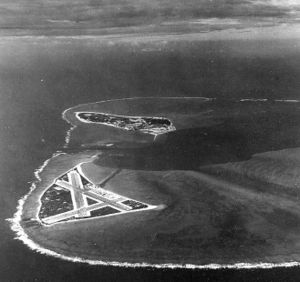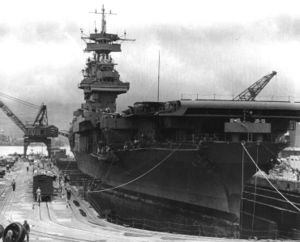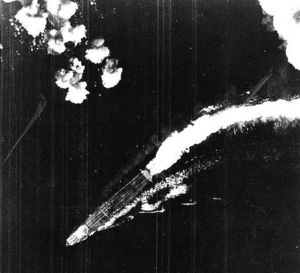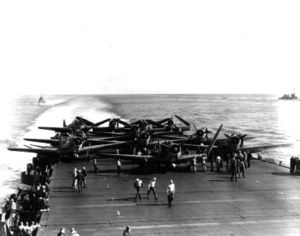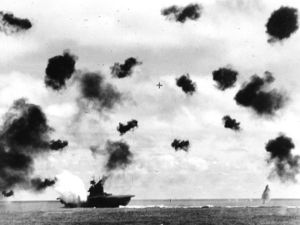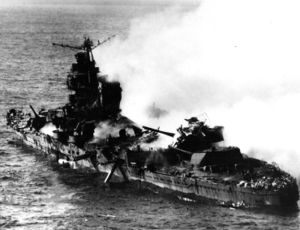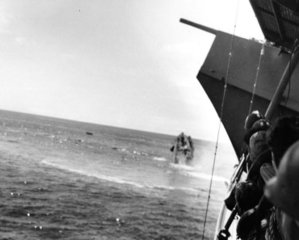Battle of Midway
2007 Schools Wikipedia Selection. Related subjects: World War II
| Battle of Midway | |||||||
|---|---|---|---|---|---|---|---|
| Part of the Pacific Theatre of World War II | |||||||
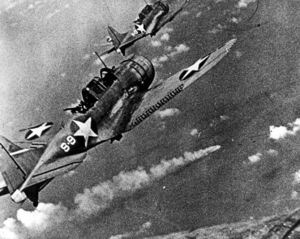 U.S. Douglas SBD Dauntless dive bomber at Midway |
|||||||
|
|||||||
| Combatants | |||||||
|
|
|||||||
| Commanders | |||||||
| Chester W. Nimitz, Frank J. Fletcher, Raymond A. Spruance |
Isoroku Yamamoto, Chuichi Nagumo, Tamon Yamaguchi † |
||||||
| Strength | |||||||
| 3 carriers, ~50 support ships, 233 carrier aircraft, 127 land-based aircraft |
4 carriers, 7 battleships, ~150 support ships, 248 carrier aircraft, 16 floatplanes |
||||||
| Casualties | |||||||
| 1 carrier sunk, 1 destroyer sunk, 307 killed |
4 carriers sunk, 1 cruiser sunk, 3,057 killed |
||||||
| Pacific campaigns 1941-42 |
|---|
| Pearl Harbour – Thailand – Malaya – Wake – Hong Kong – Philippines – Dutch East Indies – New Guinea – Singapore – Australia – Indian Ocean – Doolittle Raid – Solomons – Coral Sea – Midway |
| Pacific Ocean campaign |
|---|
| Pearl Harbour – Wake Island – Doolittle Raid – Midway – Aleutian Islands – Guadalcanal – Solomon Islands – Gilbert and Marshall Islands – Marianas and Palau – Volcano and Ryūkyū Islands |
The Battle of Midway was a pivotal naval battle in the Pacific Theatre of World War II. It took place from June 4 to June 7, 1942, approximately one month after the Battle of the Coral Sea, and six months after the Empire of Japan's attack on Pearl Harbour that had led to a state of war between the United States of America and Japan. During the battle, the United States Navy defeated a Japanese attack against Midway Atoll (located northwest of Hawai’i) and destroyed four Japanese aircraft carriers and a heavy cruiser while losing a carrier and a destroyer.
The battle was a crushing defeat for the Japanese and is widely regarded as the most important naval battle of World War II. The battle permanently weakened the Japanese Navy, particularly the loss of over 200 naval aviators. Strategically, the U.S. Navy was able to seize the initiative in the Pacific and go on the offensive.
The Japanese plan of attack, which included a secondary attack against the Aleutian Islands by a smaller fleet, was an attempt by the Japanese to lure America's few remaining carriers into a trap and sink them. The Japanese also intended to occupy Midway Atoll to extend Japan's defensive perimeter further from its home islands. This operation was considered preparatory for further attacks against Fiji and Samoa, as well as the invasion of Hawai’i.
Had the Japanese captured Midway, the northeastern Pacific Rim would have been essentially defenseless. Success also would have removed the last capital ships in the U.S. Pacific Fleet, ensuring Japanese naval supremacy in the Pacific until perhaps late 1943. Thus, the Midway operation, like the attack on Pearl Harbour that had plunged the United States into war, was not part of a campaign for the conquest of the United States itself, but was aimed at its elimination as a strategic Pacific power, thereby giving Japan a free hand in establishing its Greater East Asia Co-Prosperity Sphere. It was also hoped that another defeat would force the Americans to the negotiating table to terminate the Pacific War.
Strategic context
Japan had been highly successful in rapidly securing its initial war aims, including the reduction of the Philippines, the capture of Malaya and Singapore, and the securing of the vital resource areas in Java, Borneo, and Indonesia. As such, preliminary planning for a second phase of operations commenced as early as January 1942. However, due to strategic differences between the Imperial Army and Imperial Navy, as well as infighting between the Navy's GHQ and Admiral Yamamoto's Combined Fleet, the formulation of effective strategy was hampered, and the follow-on strategy was not finalized until April 1942. At that time, Admiral Yamamoto succeeded in winning a bureaucratic struggle that placed his operational concept — that of further operations in the Central Pacific — ahead of the other contending plans. These included operations either directly or indirectly aimed at Australia, as well as into the Indian Ocean. In the end, Yamamoto's barely-veiled threat to resign unless he got his way succeeded in carrying his agenda forward.
Yamamoto's primary strategic concern was the elimination of America's remaining carrier forces. This concern was exacerbated by the " Doolittle Raid" on Tokyo ( April 18, 1942) by U.S. Army B-25's staging off the carrier Hornet. The raid, while militarily negligible, was a severe psychological shock to the Japanese, and proved the existence of a gap in the defenses around the Japanese home islands. Sinking America's aircraft carriers and seizing Midway, the only other strategic island besides Hawaii in the East Pacific, was the only means of nullifying this threat. Yamamoto reasoned that an operation against the main carrier base at Pearl Harbour would induce them to fight. However, given the strength of American land-based airpower on Hawaii, he judged that the powerful American base could not be attacked directly. Instead, he selected the atoll of Midway, which lay at the extreme northwest end of the Hawai’ian Island chain, some 1300 miles (2100 km) from Oahu. Midway itself was not especially important in the larger scheme of Japan's intentions; however, the Japanese felt that the Americans would consider Midway a vital outpost of Pearl Harbour and would therefore strongly defend it.
The plan
As was typical of many Japanese naval plans during the Second World War, Admiral Isoroku Yamamoto's battle plan was quite complex. Additionally, his designs were predicated on optimistic intelligence information suggesting that Enterprise and Hornet, forming Task Force 16, were the only carriers available to the U.S. Pacific forces at the time. Lexington had been sunk and Yorktown had been severely mauled (and was believed sunk) at the Battle of the Coral Sea just a month earlier. Likewise, the Japanese believed that Saratoga was undergoing repairs on the West Coast after taking torpedo damage. As such, the Japanese believed that they would have at most two American fleet carriers to deal with at the point of attack.
Yamamoto's decisive battle
More important, however, was Yamamoto's belief that the Americans had been demoralized by their frequent defeats during the preceding six months. Yamamoto felt that deception would be required to lure the U.S. Fleet into a fatally compromising situation. As such, he dispersed his forces such that their full extent (particularly his battleships) would be unlikely to be discovered by the Americans prior to the decisive battle. Unfortunately for the Japanese, their emphasis on stealth and dispersal meant that none of their formations was mutually supporting. Critically, Yamamoto's supporting Main Body of battleships and cruisers would trail Vice-Admiral Chuichi Nagumo's carrier Striking Force by several hundred miles. Japan's heavy surface forces were intended to destroy whatever part of the U.S. Fleet might come to Midway's relief, once Nagumo's carriers had weakened them sufficiently for a daylight gun duel to be fought. However, their distance from Nagumo's carriers would have grave implications during the battle, as most of the battleships could have provided valuable anti-aircraft coverage instead of being reserved for a surface duel that would never be fought.
Aleutian diversion
Likewise, the Japanese operations aimed at the Aleutian Islands (Operation AL) removed yet more ships from the force that would strike at Midway. However, whereas prior histories of the battle have often characterized the Aleutians operation as a feint designed to draw American forces northwards, recent scholarship on the battle has shown that Operation AL was no such thing. In fact, according to the original Japanese battle plan, Operation AL was designed to be launched simultaneously with the initiation of operations against Midway itself. However, a 1-day delay in the sailing of Nagumo's task force had the effect of initiating Operation AL a day before its counterpart. In any event, Operation AL was a misguided expenditure of offensive assets that could have been better used in the south.
The military forces
U.S. intelligence
U.S. naval intelligence (in cooperation with the British and Dutch) had been reading parts of the primary Imperial Japanese Navy communications system ( JN-25, an enciphered code) for some time, and had made considerable progress on the latest version, which had been issued just before the attack on Pearl Harbour. The abundance of radio intelligence harvested from the Japanese Navy’s "wild-goose chase" of the Doolittle Raid task force further compromised JN-25.
Thus, by early May 1942, the Americans knew that the Japanese were preparing to launch a massive offensive against an objective (identified as "AF" in early June), and could hope to ambush them. Through analysis of other evidence, Station Hypo, Nimitz's cryptanalytic unit at Pearl Harbour, was convinced that "AF" was Midway. On the other hand, Nimitz's superior in Washington, Admiral Ernest King and the Navy's signals intelligence unit, OP-20-G, believed AF to be in the Aleutian Islands.
An ingenious suggestion by Hypo's commander, Commander Joseph J. Rochefort, gave Admiral Nimitz confirmation of AF's identity. By secure undersea cable, Rochefort asked the Midway base commander to radio a message back to Pearl Harbour stating that drinking water was running low due to a breakdown of the water plant — and to use a cipher known to have been compromised by the Japanese. Soon after, a deciphered intercept stated "AF" had fresh-water problems, and that the attack force should plan accordingly. "AF" was therefore confirmed to be Midway. Further information from JN-25 decrypts came in slowly, partly as a result of the hurried nature of Japanese preparations, and it was not until the very last minute that CINCPAC Admiral Chester Nimitz had enough information to put together an ambush for the Midway attack force. For his intelligence coup in confirming the true objective of the coming Japanese attack, Commander Rochefort was posthumously awarded the Distinguished Service Medal in 1985 (after being cheated of it at the time due to navy politics), and later the Presidential Medal of Freedom in 1986.
Prelude to battle
U.S. forces
In order to do battle with an enemy force anticipated to be composed of 4-5 carriers, Nimitz needed every available U.S. flight deck. He already had Vice Admiral William Halsey's two-carrier task force at hand — but Halsey himself was stricken with psoriasis, and had to be replaced with Rear Admiral Raymond A. Spruance (Halsey's escort commander). Nimitz also hurriedly called back Rear Admiral Frank Jack Fletcher's task force from the South West Pacific Area. They reached Pearl Harbour just in time to provision and re-sortie. USS Saratoga was still under repair and Yorktown (CV-5) herself had been severely damaged at the Battle of the Coral Sea, but Pearl Harbour Naval Shipyard worked around the clock to patch up the carrier. Though several months of repairs was estimated for the Yorktown, 72 hours at Puget Sound Naval Shipyard was enough to restore it to a battle-worthy (if still compromised) aircraft carrier. Her flight deck was patched, whole sections of internal beams were cut out and replaced, and several new squadrons (drawn from carrier Saratoga) were put aboard her. Admiral Nimitz showed total disregard for established procedure in getting his third and last available carrier ready for battle — repairs continued even as Yorktown sortied, work crews from the repair ship Vestal, herself still damaged from the raid on Pearl Harbor six months earlier, still aboard. Just three days after pulling into drydock at Pearl Harbour, the ship was again under steam, as its band played " California, Here I Come".
Japanese forces
Meanwhile, as a result of their participation in the Battle of the Coral Sea, the Japanese aircraft carrier Zuikaku was in port in Kure (near Hiroshima), waiting for an air group to be brought to her to replace her destroyed planes. The heavily damaged Shōkaku was awaiting further repairs; she had suffered three bomb hits at Coral Sea and required months in drydock. Despite the likely availability of sufficient aircraft between the two ships to re-equip Zuikaku with a composite air group, the Japanese made no serious attempt to get her into the forthcoming battle. Consequently, instead of bringing six heavy carriers into battle, Admiral Nagumo would now only have four.
Japanese strategic scouting arrangements prior to the battle also fell into disarray. A picket line of Japanese submarines was late getting into position (thanks in part to Yamamoto's haste), which let the American carriers proceed to their assembly point northeast of Midway (known as "Point Luck") without being detected. A second attempt to use 4-engine reconnaissance seaplanes to scout Pearl Harbour prior to the battle (and thereby detect the absence or presence of the American carriers), known as "Operation K" , was also thwarted when Japanese submarines assigned to refuel the search aircraft discovered that the refueling point — a hitherto deserted bay off of French Frigate Shoals — was occupied by American warships (because the Japanese had carried out an identical mission in March). Thus, Japan was deprived of any knowledge concerning the movements of the American carriers immediately before the battle. Japanese radio intercepts also noticed an increase in both American submarine activity and U.S. message traffic. This information was in the hands of both Nagumo and Yamamoto prior to the battle. However, Japanese operational plans were not changed in reaction to these disquieting omens. Nimitz, by contrast, had a very good idea of where Nagumo would appear, thanks to his superior signals intelligence.
The battle
Initial air attacks
Vice Admiral Chuichi Nagumo launched his initial attack wave of 108 aircraft at 04:30 on June 4. At the same time, the Japanese launched seven search aircraft (one of which was launched 30 minutes late), as well as combat air patrol (CAP) fighters. Japanese reconnaissance arrangements were flimsy, with too few aircraft to adequately cover the assigned search areas, and laboring under poor weather conditions to the northeast and east of the task force.
At 06:20, Japanese carrier aircraft bombed and heavily damaged the U.S. base on Midway. Midway-based Marine fighter pilots, flying Grumman F4F Wildcats and obsolete Brewster F2As, made a defense of Midway and suffered major losses. American anti-aircraft fire was accurate and intense, damaging many enemy aircraft. The Japanese strike leader, recognizing the island's strike aircraft had already departed, signaled Nagumo another mission would be necessary to neutralize the island's defenses before troops could be landed on the 7th.
Having taken off prior to the Japanese attack, American bombers based on Midway made several attacks on the Japanese carrier fleet. These included six TBF Avengers in their first combat operation, and four B-26 Marauders (armed with torpedoes). The Japanese shrugged off these attacks with almost no losses, while destroying all but three of the American bombers.
Admiral Nagumo, in accordance with Japanese carrier operational practices of the time, had kept half of his aircraft in reserve. These comprised two squadrons each of dive-bombers and torpedo bombers. The latter were armed with torpedoes for an antiship strike, should any American warships be located. The dive-bombers were, as yet, unarmed. As a result of the attacks from Midway, as well as the morning flight leader's recommendation regarding the need for a second strike, Admiral Nagumo at 07:15 ordered his reserve planes to be re-armed with general purpose contact bombs for use on land targets. Re-arming had been underway for about 30 minutes, when at 07:40 a scout plane from the cruiser Tone signaled the discovery of a sizable American naval force to the east. Nagumo quickly reversed his re-arming order, and asked the scout plane to ascertain the composition of the American force.
Nagumo was now in a quandary. Rear Admiral Tamon Yamaguchi, leading Carrier Division 2 ( Hiryū and Sōryū), recommended Nagumo strike immediately with the forces at hand. Nagumo might have had an opportunity to immediately launch some or all of his reserve strike force to attack the American ships., but had to act quickly, as his Midway strike force would be returning shortly. They would be low on fuel, and carrying wounded crewmen, and would need to land promptly. Spotting his flight decks and launching aircraft would require at least 30–45 minutes to accomplish. Furthermore, by spotting and launching immediately, he would be committing some of his reserve strike aircraft to battle without proper antiship armament. Japanese carrier doctrine preferred fully constituted strikes, and in the absence of a confirmation of whether the American force contained carriers, Nagumo's reaction was cautious. In addition, the impending arrival of yet more American air strikes at 07:53 made Nagumo's window of decision quite short. In the end Nagumo made the fateful decision to wait for his first strike force to land, and then launch the reserve strike force (which would by then be properly armed).
Attacks on the Japanese fleet
Meanwhile, the Americans had already launched their carrier aircraft against the Japanese. Admiral Fletcher, in overall command on board Yorktown, and armed with PBY sighting reports from the early morning, ordered Spruance to launch against the Japanese as soon as was practical. At the urging of Halsey's Chief of Staff, Captain Miles Browning, Spruance commenced launching from his carriers Enterprise and Hornet at 07:00. Fletcher, upon completing his own scouting flights, followed suit at 08:00 from Yorktown. However, American flight deck operations were not nearly as proficient as their enemy's at this point in the war, and the American squadrons were launched in piecemeal fashion, proceeding to the target in several different groups. This diminished the overall impact of the American attacks, and greatly increased their casualties.
American carrier aircraft began attacking the Japanese carrier fleet at 09:20, with first Torpedo Squadron 8 ( VT-8), followed by VT-6 (at 09:40) attacking without fighter support. VT-8 was completely annihilated, and VT-6 nearly so, with no hits against the enemy to show for their efforts. The Japanese CAP ( Combat Air Patrol), flying the much faster Mitsubishi Zero fighter, made short work of the slow, under-armed American torpedo planes. However, despite their terrible sacrifices, the American torpedo planes indirectly achieved two important results. First, they kept the Japanese off balance, with no ability to prepare and launch their own counterstrike. Second, their attacks had pulled the Japanese combat air patrol out of position — not in terms of altitude (as has commonly been described), but by laterally distorting the CAP coverage over the Japanese fleet. The appearance of a third torpedo plane attack from the SE by VT-3 at 10:00 very quickly drew the majority of the Japanese CAP into the southeast quadrant of the fleet.
By chance, at the same time VT-3 was sighted by the Japanese, two separate formations (comprising three squadrons total) of American SBD Dauntless dive-bombers were approaching the Japanese fleet from the northeast and southwest. These formations, despite having had difficulty in locating the Japanese carriers had now — by sheer luck and some good decision-making on the part of their respective squadron commanders — arrived in a perfect position to attack the Japanese. Armed Japanese strike aircraft filled the hangar decks at the time of the fateful attack, fuel hoses snaking across the decks as refueling operations were hastily completed, and the constant change of ordnance meant that bombs and torpedoes were stacked around the hangars rather than being stowed safely in the magazines. The Japanese carriers were in an extraordinarily vulnerable position.
However, contrary to some accounts of the battle, recent research has demonstrated that the Japanese were not prepared to launch a counterstrike against the Americans at the time they were decisively attacked. Due to the constant flight deck activity associated with combat air patrol operations during the preceding hour, the Japanese had never had an opportunity to spot their reserve strike force for launch. The few aircraft on the Japanese flight decks at the time of the attack were either CAP fighters, or (in the case of Sōryū) strike fighters being spotted to augment the CAP. Regardless, the moment of opportunity was exploited for all it was worth by the American bomber pilots.
Beginning at 10:22, Enterprise aircraft attacked carrier Kaga, with Akagi being struck four minutes later. To the north, Yorktown’s aircraft attacked Sōryū. Simultaneously, VT-3 was targeting Hiryū, although the American torpedo aircraft again scored no hits. The dive-bombers, however, had better fortune. Within six minutes, the SBDs made their attack runs and left all three of their targets heavily ablaze. Akagi was hit by just one bomb, which was sufficient; it penetrated to the upper hangar deck and exploded among the armed and fueled aircraft there. One extremely near miss also slanted in and exploded underwater, bending the flight deck upward with the resulting geyser and causing crucial rudder damage. Sōryū took three bomb hits in the hangar decks; Kaga took at least four and likely more. All three carriers were out of action, and would eventually be abandoned and scuttled.
Subsequent to the air attacks, the American submarine Nautilus (SS-168) fired torpedoes at what her crew thought was the Sōryū, but which later research suggests was the Kaga. The Nautilus crew claimed that one torpedo hit the carrier, causing "flames". However, the surviving crew of the Kaga reported no torpedo hits after the air attack. Of the four fish fired, one failed to run, two ran erratically, and the fourth was a 'dud,' impacting amidships and breaking in half.
Japanese counterattacks
Hiryū, now the sole surviving Japanese flight deck, wasted little time in counterattacking. The first strike of Japanese dive-bombers badly damaged the Yorktown, yet her engineers patched her up so quickly that the second strike of torpedo bombers mistook her for an intact carrier. Despite Japanese hopes to even the battle by eliminating two carriers with two strikes, Yorktown absorbed both Japanese attacks, the second attack believing mistakenly that Yorktown had already been sunk and that they were attacking Enterprise. She was now out of the battle, but Task Force 16's two carriers had escaped undamaged as a result. (Yorktown would later be sunk, during salvage efforts, by torpedoes from a Japanese submarine on June 7. The same torpedo salvo would also sink the destroyer Hammann.) When American scout aircraft subsequently located Hiryū later in the afternoon, Enterprise launched a final strike of dive bombers against the last Japanese carrier that left her ablaze. Hornet's strike, launching late due to a communications error, concentrated on the remaining surface ships but failed to score any hits.
As darkness fell, both sides took stock, and made tentative plans for continuing the action. Admiral Spruance was now in tactical command of the American forces as Admiral Fletcher had been obliged to abandon the derelict Yorktown. Spruance knew that he had won a great victory, but he was still unsure of what Japanese forces remained at hand, and was determined to safeguard both Midway and his carriers. Consequently, he decided to retire east during the evening, so as to not run into a night action with Japanese surface forces that might still be in the area. In the early morning hours, he returned to the west to be in a position to cover Midway should an invasion develop in the morning.
For his part, Yamamoto initially decided to continue the effort, and sent his remaining surface forces searching eastward for the American carriers. Simultaneously, a cruiser raiding force was detached to bombard the island that very night. Eventually, however, as the night waned without any sign of the Americans, the reality of the situation imposed its own logic, and at 02:55 Yamamoto ordered his various forces to retire to the west.
While beating its retreat in close column at night, the Japanese cruiser bombardment force suffered a further trial. A sighting of the American submarine Tambor forced the cruiser formation to initiate radical evasive maneuvers. Mogami failed to adjust its course correctly for a column turn, and rammed the port quarter of her sistership Mikuma. Over the following two days, first Midway and then Spruance's carriers launched several successive strikes against the stragglers. Mikuma was eventually sent to the bottom, while Mogami managed to successfully fend off the bombers, and lived to fight another day. US Marine Captain Richard E. Fleming was posthumously awarded the Medal of Honour for his attack on the Mikuma, although contemporary research has revealed that neither Fleming's bomb nor his aircraft actually struck the ship itself.
Aftermath
After scoring a clear victory, American forces retired. Japan's loss of four fleet carriers ( Kaga, Akagi, Sōryū, and Hiryū) — leaving only Zuikaku and Shōkaku — stopped the expansion of the Japanese Empire in the Pacific.
With the US Navy now having clawed its way back to a rough parity of fleet carriers, the Americans could contemplate taking to the offensive for the first time in the war. Shortly thereafter, the Americans would invade Guadalcanal, initiating the attritional struggle in the Solomon Islands that would permanently wreck the Japanese Navy and its elite naval air groups.
Impact
Although the battle has often been called "the turning point of the Pacific", it clearly did not win the Pacific War overnight for the Americans. The Japanese navy continued to fight ferociously, and it would be many more months before the U.S. would move from a state of naval parity to that of increasingly clear supremacy. Nor, given the vast disparity in economic strength between the two combatants, is it even remotely likely that the Americans would have lost the war against Japan had they lost the battle. Thus, Midway was not "decisive" in the same sense that Salamis or Trafalgar was decisive. However, victory at Midway gave the U.S. the opportunity to seize the strategic initiative, inflicted irreparable damage on the Japanese carrier force, and shortened the war in the Pacific.
Just two months later, the US took the offensive and attacked Guadalcanal, catching the Japanese off-balance. Given a defeat instead of a major victory at Midway, the US may not have struck at such an early date, or had the same degree of success. Securing Allied supply lines to Australia and the Indian Ocean in this time frame, along with the heavy attrition inflicted on the Japanese at Guadalcanal, had far-reaching effects on the length of the war (see Guadalcanal campaign, Aftermath and Historical Significance.) For example, the British defense of the Suez Canal against the Afrika Korps was resupplied and reinforced via Allied shipping lanes in the Indian Ocean.
While Midway did not see the destruction of Japanese naval aviation, it did deal it a heavy blow. The pre-war Japanese training program produced pilots of exceptional quality, but at a painfully slow rate. This small group of elite aviators were combat hardened veterans. At Midway, the Japanese lost as many of these pilots in a single day as their pre-war training program produced in a year. In the subsequent battles around Guadalcanal in late 1942, such as Eastern Solomons and Santa Cruz, Japanese naval aviation was ground down by attrition. Although war-time Japanese training programs produced pilots, they were insufficiently trained as the war continued, an imbalance that became worse as increasingly potent US fighters became available that clearly outmatched Japanese aircraft. By mid-1943, the combination of the Battle of Midway and the losses in the Solomons had decimated Japanese naval aviation. Worse for the Japanese, their habit of leaving expert pilots in combat was detrimental to the training of their forces. The US Navy by contrast rotated its best aviators home on a regular basis to teach their young pilot candidates the techniques they would use to defeat the Empire of Japan.
Even more important, though, was the irredeemable loss of four of Japan's fleet carriers. These ships would not be replaced, unit for unit, until early in 1945. In the same span of time, the U.S. Navy commissioned more than two dozen fleet and light fleet carriers, and numerous escort carriers. Thus, Midway permanently damaged the Japanese Navy's striking power, and measurably shortened the period during which the Japanese carrier force could fight on advantageous terms.
The importance of the Battle of Midway can also be assessed by considering the hypothetical scenario of an American defeat and the destruction of the US aircraft carrier fleet. By any analysis, a loss of that magnitude would have prolonged the war in the Pacific. With only two carriers ( Saratoga and Wasp) available, the U.S. would have been forced onto the defensive for at least the remainder of 1942. The Japanese could have continued their advance on the New Hebrides and cut off communication with Australia, and completed their conquest of New Guinea. Furthermore, a catastrophic failure at Midway might have resulted in the removal of key figures like Nimitz and Spruance from their positions. Offensive operations in the Pacific might have been delayed until as late as mid-1943, when Essex and Independence class carriers became available in appreciable numbers. A hypothetically longer Pacific war does raise the question of the role the Soviet Union would have played in Japan's demise, and whether the USSR would have gained a postwar presence in a partitioned Japan, similar to that of Germany. The actual implications of an American defeat are unknowable, but there is little question that losing at Midway would have narrowed U.S. options dramatically, at least in the short term.
Discovery
U.S. vessels
Due to the extreme depth of the ocean in the area of the battle (more than 17,000 feet/5200 m), researching the battlefield has presented extraordinary difficulties. However, on May 19, 1998, Robert Ballard and a team of scientists & Midway veterans (including Japanese participants) located and photographed Yorktown. The ship was remarkably intact for a vessel that sank in 1942; much of the original equipment, and even the original paint scheme were still visible.
Japanese vessels
Ballard's subsequent search for the Japanese carriers was ultimately unsuccessful. In September 1999, a joint expedition between Nauticos Corp. and the U.S. Naval Oceanographic Office searched for the Japanese aircraft carriers. Using advanced renavigation techniques in conjunction with the ship's log of the submarine USS Nautilus, the expedition located a large piece of wreckage, which was subsequently identified as having come from the upper hangar deck of carrier Kaga. The main wreck, however, has yet to be located.
In film
The Battle of Midway has been featured in several motion pictures. The first film about the battle was directed by John Ford, who used colour motion picture from U.S. Navy of the actual battle, releasing an award-winning documentary called The Battle of Midway in 1942. Subsequently, the movie Midway, directed by Jack Smight, was released in 1976. This film generally portrayed the events fairly accurately, although it was criticized for suffering from several flaws (including a preposterous romance, the presence of American F4U Corsair fighters, which were not even operational yet), inaccurate warship models, and the promotion of Hypo's Commander Rochefort to Fleet Intelligence Officer).
In addition, the 1976 movie vividly depicts Grumman F6F Hellcat carrier landings whereas the battle involved its predecessor, the Grumman F4F Wildcat, which strongly resembles the Hellcat but is distinguishable during landings due to the Wildcat's narrow-track landing gear. The Hellcat did not become operational until 1943.
Trivia
- This major defeat for Japan came six months after the beginning of open warfare against the United States. That is almost exactly the maximum amount of time that Admiral Isoroku Yamamoto predicted he would have the advantage over the enemy before the tide would turn in its favour.
